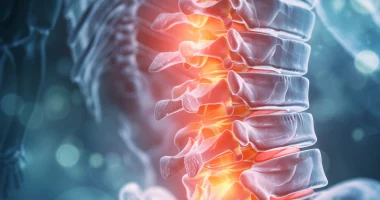Chronic bifascicular block
The bifascicular block is a simultaneous lesion of two of the three main conductive bundles of the His-Purkinje system (right bundle branch (RBB), anterior and posterior branches of the left bundle branch (LBB)). Technically, complete LBB is also bifascicular, but traditionally, the term “bifascicular block” refers to these two pathologic conditions:
- Complete block of RBB + block of the anterior branch of the LBB
- Complete block of the RBB + block of the posterior branch of the LBB.
Clinically, the bifascicular blockade is often silent, although, in some patients, it can worsen heart failure symptoms due to significant QRS widening and reduced ejection fraction. Over time, in a proportion of patients (about 1% per year), bifascicular block may progress to complete block and be accompanied by a decreasing heart rate; at that point, episodes of generalized weakness and dizziness/loss of consciousness may occur, requiring pacemaker implantation.
The main causes of the bifascicular blockade are chronic CAD, progression of degenerative diseases of the conducting system (Lev’s disease, Lenegre’s disease), and acute myocardial injury (myocardial ischemia/ infarction, myocarditis, surgical interventions).
Anatomical information
The bundle of cells of the cardiac conduction system located under the atrioventricular node and the interventricular septum is called the His bundle. It consists of the right and left branches. The branches of His’ bundle are the elements responsible for transmitting electrical excitation to the cardiac ventricles. They, in turn, are divided into branches and are located on both sides of the interventricular septum. In the ventricular myocardium, the branches separate into conductive bundles of cardiac myocytes (Purkinje fibers).
Danger of His bundle block
Poor conduction via the His bundle is a dangerous pathology affecting the heart muscle’s functional work. An incomplete blockade of the right bundle leads to partial impairment of impulse transmission on the right side. Life-threatening is a complete blockade of the right bundle, in which the transmission of excitation to the heart is completely stopped.
In clinical practice, blockade of the right His bundle is uncharacteristic for young people (no more than 0.1%). This disease develops with age and more often affects the cardiovascular system of men.
Causes of the development of the His bundle blockade
The main causes of the disease are cardiac abnormalities:
- cardiomyopathy;
- myocardial infarction;
- hypertension;
- heart failure;
- autoimmune diseases;
- ischemic heart disease;
- heart valve deformities;
- inflammation of the heart muscle (myocarditis);
- congenital malformations of the cardiovascular system.
Among congenital defects, dangerous anomalies such as defects of the interatrial and interventricular septum, stenosis of the pulmonary artery orifice, underdevelopment of the segment of the bundle branch of His, and other malformations causing overload of the right ventricle deserve special attention.
Heart malfunctions can also provoke acquired diseases:
- heart tumors;
- of myocardial pathology;
- chest trauma;
- hyperkalemia;
- progressive types of muscular dystrophy;
- chronic respiratory diseases.
The development of abnormalities in the conduction system of the heart is also influenced by:
- toxic poisonings;
- hormonal disorders;
- autonomic dysfunction;
- electrolyte disorders: Insufficient potassium, sodium, and magnesium blood levels can cause serious malfunctions in all organs and systems.
Symptoms
The difficulty in diagnosing incomplete RBB is that there are no obvious symptoms. As a rule, pathology is detected on routine ECG.
Apparent clinical abnormalities in organic disease are characteristic of complete right bundle block. Changes in cardiac tones are audible on auscultation in one-third of patients with cardiac anomalies. An apparent failure of heart rhythm in the RBB can be seen on ECG.
Types of His bundle block
Any blockades of the His bundles are characterized by slowing down or a complete stop of transmission of electrical impulses along two or three branches, respectively.
Based on the anatomical structure of the conduction system of the heart, the following blockades are distinguished:
1. Monofascicular – one branch is affected.
A slight widening of the QRS complex is observed in any single-branch blockade. For complete blockade of the right His bundle, this parameter may increase to 0.12 s or more. Monofascicular blockade, in turn, is subdivided into:
- of the right bundle blockage;
- of the anterior branch of the left bundle;
- of the posterior branch of the left bundle.
2. Bifascicular – when two branches of the His bundle are affected.
Bifascicular blockades cause a high degree of conduction system pathology within the cardiac ventricles and provoke a much larger area of myocardial damage than single-branch blockades. The following types of bifascicular blocks are distinguished:
- block of two branches of the left bundle;
- blockade of the anterior branch of the left bundle and right bundle;
- blockade of the posterior branch of the left bundle and right bundle.
3. Trifascicular blockades are blockades in which all three branches of the His bundle are affected at the same time.
In an incomplete trifascicular block, the electrical impulse is transmitted from the atria to the ventricles through the least affected branch of the His bundle. Atrioventricular conduction is slowed or blocked completely. The ECG of the incomplete trifascicular blockade shows deformation and expansion of the QRS complex, which is similar in appearance to the blockade of two branches of the His bundle with a complete absence of impulse conduction.
Diagnosis of blockages
The cardiologist makes an anamnesis of the disease based on a questioning and patient ECG study. To clarify the cause of the pathology and following diagnostic measures are also used:
- MRI;
- chest CT scan;
- echocardiography;
- PET scan of the heart;
- daily ECG monitoring
Prognosis in chronic bifascicular block
In the absence of a progressive right bundle block, the typical symptomatology is not dangerous and does not require therapeutic correction. However, a cardiologist must closely monitor and treat the patient in case of disease extension and deterioration of the cardiac conduction system.
Clinical practice shows that prognosis is always favorable if the patient does not have other aggravating pathologies of organs and systems. There is no evidence of the development of isolated bundle blockade into a complete blockade.
Treatment of His bundle blockade
In case of suspected pathology of the elements of the cardiac conduction system, it is necessary to undergo a consultation with an arrhythmologist, cardiologist, and, in some cases, cardiac surgeon. In case of incomplete block of the His bundle, the main treatment should be directed to the organ or system of organs that provoked abnormal the development of blockade.
There is no general scheme of therapy for the His bundle blockade. Suppose impulse transmission disorders are caused by angina pectoris, hypertension, or heart failure. In that case, the primary treatment is based on using hypotensive and antiarrhythmic agents and cardiac glycosides.
In the case of incomplete blockade, if the patient does not experience discomfort and can lead an everyday life, only wait-and-see tactics are required.
Blockages are treated surgically in cases of genetic abnormalities or congenital malformations. Indications for surgery include frequent fainting and life-threatening heart abnormalities. In modern cardiac surgery, a pacemaker—a device that generates contractions and provides a set heart rhythm—is installed to correct the work of the heart’s conducting system.
Distal blockades are poorly amenable to drug treatment. Cardiac electrical stimulation is considered to be the most effective treatment. For acute blockages that were provoked by myocardial infarction, temporary electrostimulation is indicated. For persistent blockages, permanent electrostimulation is prescribed.
All these treatment options are available in more than 560 hospitals worldwide (https://doctor.global/results/diseases/chronic-bifascicular-block). For example, Dual chamber pacemaker insertion can be done in 11 clinics across Turkey for an approximate price of $6.7 K (https://doctor.global/results/asia/turkey/all-cities/all-specializations/procedures/dual-chamber-pacemaker-insertion).
Prevention of His bundle blockade
To prevent the development of blockages and other cardiovascular pathologies, it is recommended to follow general rules:
- prolonged sleep;
- an active lifestyle;
- smoking and alcohol cessation;
- balanced diet;
- elimination of stress and nervous situations;
- regular diagnosis and treatment of heart disease.



